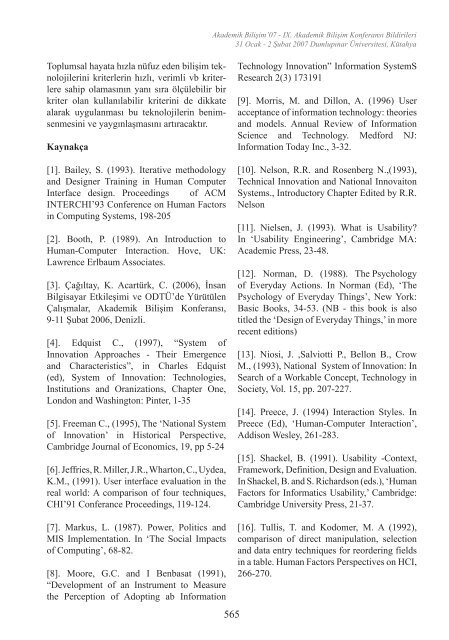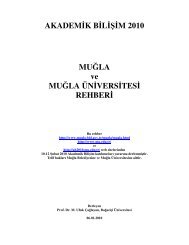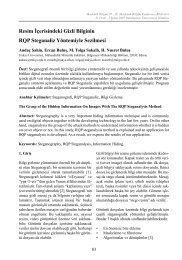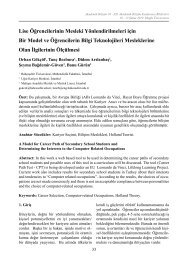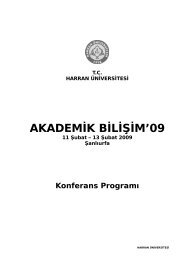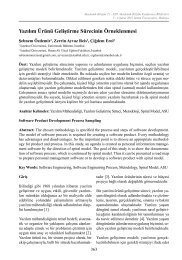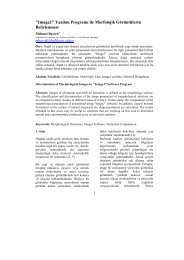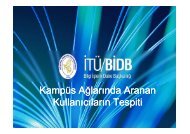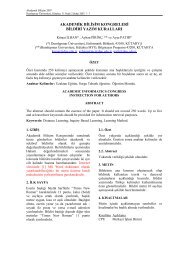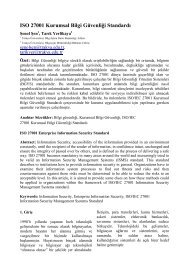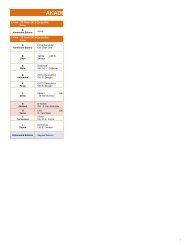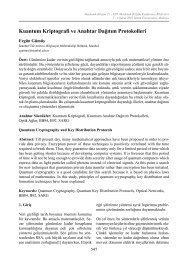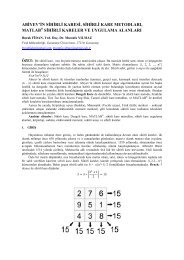- Page 2 and 3:
SponsorlarDestekçiler
- Page 4 and 5:
Copyright İnternet Teknolojileri D
- Page 6 and 7:
Giriş: İçindekilerRSA Şifreleme
- Page 8 and 9:
Giriş: İçindekilerÇok Uluslu,
- Page 10 and 11:
Giriş: İçindekilerGoogle Arama M
- Page 12 and 13:
Giriş: İçindekilerSABPO Metodolo
- Page 14 and 15:
Giriş: İçindekilerCoğrafi Bilgi
- Page 16 and 17:
Giriş: KurullarYerel Organizasyon
- Page 18 and 19:
Giriş: Konferans ProgramıEGüvenl
- Page 20 and 21:
Giriş: Konferans ProgramıBSosyal
- Page 22 and 23:
Giriş: Konferans ProgramıENetwork
- Page 24 and 25:
Giriş: Konferans Programı14:00 -
- Page 26 and 27:
Giriş: Konferans ProgramıDYazıl
- Page 28 and 29:
Giriş: Konferans ProgramıCİntern
- Page 30 and 31:
Giriş: Konferans Programı16:00 -
- Page 32 and 33:
XXVIII
- Page 34 and 35:
XXX
- Page 36 and 37:
Giriş: Açılış KonuşmasıBu ko
- Page 38 and 39:
Giriş: Açılış Konuşmasıulusl
- Page 41:
Akademik Bilişim’07 - IX. Akadem
- Page 44 and 45:
Gazi Üniversitesi Uzaktan Eğitim
- Page 46 and 47:
Gazi Üniversitesi Uzaktan Eğitim
- Page 49 and 50:
Akademik Bilişim’07 - IX. Akadem
- Page 51 and 52:
Akademik Bilişim’07 - IX. Akadem
- Page 53 and 54:
Akademik Bilişim’07 - IX. Akadem
- Page 55 and 56:
Akademik Bilişim’07 - IX. Akadem
- Page 57 and 58:
Akademik Bilişim’07 - IX. Akadem
- Page 59 and 60:
da doğurmaktadır. Açıköğretim
- Page 61 and 62:
Akademik Bilişim’07 - IX. Akadem
- Page 63 and 64:
sayesinde 2 TeraBayt sığaya sahip
- Page 65 and 66:
Akademik Bilişim’07 - IX. Akadem
- Page 67 and 68:
Akademik Bilişim’07 - IX. Akadem
- Page 69:
Akademik Bilişim’07 - IX. Akadem
- Page 72 and 73:
Türkçe Bir Sözlükteki Tanımlar
- Page 74 and 75:
Türkçe Bir Sözlükteki Tanımlar
- Page 76 and 77:
Türkçe Bir Sözlükteki Tanımlar
- Page 78 and 79:
Türkçe Bir Sözlükteki Tanımlar
- Page 80 and 81:
İnternet Perspektifinde Ergenlerin
- Page 82 and 83:
İnternet Perspektifinde Ergenlerin
- Page 85 and 86:
Akademik Bilişim’07 - IX. Akadem
- Page 87 and 88:
Akademik Bilişim’07 - IX. Akadem
- Page 89:
Akademik Bilişim’07 - IX. Akadem
- Page 92 and 93:
Geleceğin Çokluortam Erişim Stan
- Page 94 and 95:
Geleceğin Çokluortam Erişim Stan
- Page 96 and 97:
Geleceğin Çokluortam Erişim Stan
- Page 98 and 99:
Çok Katmanlı Algılayıcı ve Ger
- Page 100 and 101:
Çok Katmanlı Algılayıcı ve Ger
- Page 102 and 103:
Çok Katmanlı Algılayıcı ve Ger
- Page 104 and 105:
Çok Boyutlu Görüntüler için JP
- Page 106 and 107:
Çok Boyutlu Görüntüler için JP
- Page 108 and 109:
Geliştirilmekte Olan Görüntü S
- Page 110 and 111:
Geliştirilmekte Olan Görüntü S
- Page 112 and 113:
Geliştirilmekte Olan Görüntü S
- Page 114 and 115:
DICOM Görüntü StandardıMustafa
- Page 116 and 117:
DICOM Görüntü StandardıMustafa
- Page 118 and 119:
DICOM Görüntü StandardıMustafa
- Page 120 and 121:
RSA Şifreleme Algoritmasının Pol
- Page 122:
RSA Şifreleme Algoritmasının Pol
- Page 129 and 130:
fında elde edilecek video orijinal
- Page 131 and 132:
Ancak bilinen metinlerle şifre kı
- Page 133 and 134:
tam sayı anahtarın bit değerleri
- Page 135 and 136:
Akademik Bilişim’07 - IX. Akadem
- Page 137 and 138:
Akademik Bilişim’07 - IX. Akadem
- Page 139 and 140:
Akademik Bilişim’07 - IX. Akadem
- Page 141 and 142:
Akademik Bilişim’07 - IX. Akadem
- Page 143 and 144:
Akademik Bilişim’07 - IX. Akadem
- Page 145 and 146:
Akademik Bilişim’07 - IX. Akadem
- Page 147 and 148:
Akademik Bilişim’07 - IX. Akadem
- Page 149 and 150:
Akademik Bilişim’07 - IX. Akadem
- Page 151 and 152:
Akademik Bilişim’07 - IX. Akadem
- Page 153 and 154:
Akademik Bilişim’07 - IX. Akadem
- Page 155 and 156:
düşündürür. Bu yüzden kişini
- Page 157 and 158:
Akademik Bilişim’07 - IX. Akadem
- Page 159 and 160:
Akademik Bilişim’07 - IX. Akadem
- Page 161 and 162:
Akademik Bilişim’07 - IX. Akadem
- Page 163 and 164:
• Sayfa düzeni için tabloları
- Page 165 and 166:
Akademik Bilişim’07 - IX. Akadem
- Page 167 and 168:
Akademik Bilişim’07 - IX. Akadem
- Page 169 and 170:
Akademik Bilişim’07 - IX. Akadem
- Page 171 and 172:
Akademik Bilişim’07 - IX. Akadem
- Page 173 and 174:
Akademik Bilişim’07 - IX. Akadem
- Page 175 and 176:
Akademik Bilişim’07 - IX. Akadem
- Page 177 and 178:
Akademik Bilişim’07 - IX. Akadem
- Page 179 and 180:
Akademik Bilişim’07 - IX. Akadem
- Page 181 and 182:
Akademik Bilişim’07 - IX. Akadem
- Page 183 and 184:
Akademik Bilişim’07 - IX. Akadem
- Page 185 and 186:
kayesi anlattıyor. “15 yıl önc
- Page 187 and 188:
Akademik Bilişim’07 - IX. Akadem
- Page 189 and 190:
Akademik Bilişim’07 - IX. Akadem
- Page 191 and 192:
Akademik Bilişim’07 - IX. Akadem
- Page 193 and 194:
Akademik Bilişim’07 - IX. Akadem
- Page 195 and 196:
Akademik Bilişim’07 - IX. Akadem
- Page 197 and 198:
felsefi tartışma ile başlanır.A
- Page 199 and 200:
Öğrenci çalışmaları dosyasın
- Page 201 and 202:
Akademik Bilişim’07 - IX. Akadem
- Page 203 and 204:
Akademik Bilişim’07 - IX. Akadem
- Page 205 and 206:
Şekil 5. LMDS paket formatıKullan
- Page 207 and 208:
Akademik Bilişim’07 - IX. Akadem
- Page 209 and 210:
Akademik Bilişim’07 - IX. Akadem
- Page 211 and 212:
Akademik Bilişim’07 - IX. Akadem
- Page 213 and 214:
Akademik Bilişim’07 - IX. Akadem
- Page 215 and 216:
Akademik Bilişim’07 - IX. Akadem
- Page 217 and 218:
de CPU 314C-2DP kullanılmıştır.
- Page 219 and 220:
Akademik Bilişim’07 - IX. Akadem
- Page 221 and 222:
Tablo 1, uzaktan eğitimde kullanı
- Page 223 and 224:
4.5.6.7.8.9.Bağlantı ve erişim p
- Page 225 and 226:
Akademik Bilişim’07 - IX. Akadem
- Page 227 and 228:
Akademik Bilişim’07 - IX. Akadem
- Page 229 and 230:
Akademik Bilişim’07 - IX. Akadem
- Page 231 and 232:
Akademik Bilişim’07 - IX. Akadem
- Page 233 and 234:
münden, %27 sinin Bilgisayar ve Ö
- Page 235 and 236:
“Bir başka nedense, öğrencinin
- Page 237 and 238:
Akademik Bilişim’07 - IX. Akadem
- Page 239 and 240:
ir anket çalışmasında öğrenci
- Page 241 and 242:
Akademik Bilişim’07 - IX. Akadem
- Page 243 and 244:
Akademik Bilişim’07 - IX. Akadem
- Page 245 and 246:
Hazırlanan bir ara yüzden, kullan
- Page 247 and 248:
Akademik Bilişim’07 - IX. Akadem
- Page 249 and 250:
Akademik Bilişim’07 - IX. Akadem
- Page 251 and 252:
Akademik Bilişim’07 - IX. Akadem
- Page 253 and 254:
Akademik Bilişim’07 - IX. Akadem
- Page 255 and 256:
lı, ulusal lisans kapsamında üni
- Page 257 and 258:
ANKOS ile pazarlık yapılması ül
- Page 259 and 260:
Akademik Bilişim’07 - IX. Akadem
- Page 261 and 262:
Kütüphanesi’nin evsahipliğini
- Page 263 and 264:
F.Kaynak ya da kurum türüne göre
- Page 265 and 266:
Akademik Bilişim’07 - IX. Akadem
- Page 267 and 268:
Akademik Bilişim’07 - IX. Akadem
- Page 269 and 270:
Akademik Bilişim’07 - IX. Akadem
- Page 271 and 272:
Akademik Bilişim’07 - IX. Akadem
- Page 273 and 274:
Akademik Bilişim’07 - IX. Akadem
- Page 275 and 276:
Akademik Bilişim’07 - IX. Akadem
- Page 277 and 278:
Akademik Bilişim’07 - IX. Akadem
- Page 279 and 280:
Akademik Bilişim’07 - IX. Akadem
- Page 281 and 282:
Akademik Bilişim’07 - IX. Akadem
- Page 283 and 284:
Akademik Bilişim’07 - IX. Akadem
- Page 285 and 286:
Akademik Bilişim’07 - IX. Akadem
- Page 287 and 288:
Akademik Bilişim’07 - IX. Akadem
- Page 289 and 290:
Akademik Bilişim’07 - IX. Akadem
- Page 291 and 292:
Akademik Bilişim’07 - IX. Akadem
- Page 293 and 294:
Akademik Bilişim’07 - IX. Akadem
- Page 295 and 296:
Akademik Bilişim’07 - IX. Akadem
- Page 297 and 298:
zaman ek sunucularla çok daha ucuz
- Page 299 and 300:
Akademik Bilişim’07 - IX. Akadem
- Page 301 and 302:
Akademik Bilişim’07 - IX. Akadem
- Page 303 and 304:
Akademik Bilişim’07 - IX. Akadem
- Page 305 and 306:
teknolojilerin kullanımının hala
- Page 307 and 308:
Akademik Bilişim’07 - IX. Akadem
- Page 309 and 310:
Akademik Bilişim’07 - IX. Akadem
- Page 311 and 312:
Akademik Bilişim’07 - IX. Akadem
- Page 313 and 314:
Akademik Bilişim’07 - IX. Akadem
- Page 315 and 316:
Akademik Bilişim’07 - IX. Akadem
- Page 317 and 318:
cu açıklamaktadır. 2005-2006 eğ
- Page 319 and 320:
Akademik Bilişim’07 - IX. Akadem
- Page 321 and 322:
Akademik Bilişim’07 - IX. Akadem
- Page 323 and 324:
Akademik Bilişim’07 - IX. Akadem
- Page 325 and 326:
Akademik Bilişim’07 - IX. Akadem
- Page 327 and 328:
Akademik Bilişim’07 - IX. Akadem
- Page 329 and 330:
Akademik Bilişim’07 - IX. Akadem
- Page 331 and 332:
Akademik Bilişim’07 - IX. Akadem
- Page 333 and 334:
lamakta, işe gidip-gelmek için ha
- Page 335 and 336:
çalışma şartları, diğer çal
- Page 337 and 338:
Yani, iş tamamen tele çalışmaya
- Page 339 and 340:
Akademik Bilişim’07 - IX. Akadem
- Page 341 and 342:
dığı oyun yanlış kanallara yö
- Page 343 and 344:
Akademik Bilişim’07 - IX. Akadem
- Page 345 and 346:
Akademik Bilişim’07 - IX. Akadem
- Page 347 and 348:
Akademik Bilişim’07 - IX. Akadem
- Page 349 and 350:
Akademik Bilişim’07 - IX. Akadem
- Page 351 and 352:
Akademik Bilişim’07 - IX. Akadem
- Page 353 and 354:
Akademik Bilişim’07 - IX. Akadem
- Page 355 and 356:
Akademik Bilişim’07 - IX. Akadem
- Page 357 and 358:
Akademik Bilişim’07 - IX. Akadem
- Page 359 and 360:
olacaktır. Buna ilave olarak, izle
- Page 361 and 362:
Akademik Bilişim’07 - IX. Akadem
- Page 363 and 364:
Akademik Bilişim’07 - IX. Akadem
- Page 365 and 366:
ilgisayar kullanıcısı) içermekt
- Page 367 and 368:
Akademik Bilişim’07 - IX. Akadem
- Page 369 and 370:
Akademik Bilişim’07 - IX. Akadem
- Page 371 and 372:
3. Çok Katmanlı MimariŞu an hizm
- Page 373:
si (t y) ve bekleme gecikmesi (t q)
- Page 376 and 377:
Kampüs Ağında Sanal Özel Ağ Ya
- Page 378 and 379:
Kampüs Ağında Sanal Özel Ağ Ya
- Page 380 and 381:
Kampüs Ağında Sanal Özel Ağ Ya
- Page 382 and 383:
İzmir Ekonomi Üniversitesi Kampü
- Page 384 and 385:
İzmir Ekonomi Üniversitesi Kampü
- Page 386 and 387:
İzmir Ekonomi Üniversitesi Kampü
- Page 388 and 389:
P2P ile Mücadele ve KSU-NET Örne
- Page 390 and 391:
P2P ile Mücadele ve KSU-NET Örne
- Page 392 and 393:
Bilgisayar Ağ Sistemleri Güvenli
- Page 394 and 395:
Bilgisayar Ağ Sistemleri Güvenli
- Page 396 and 397:
Bilgisayar Ağ Sistemleri Güvenli
- Page 398 and 399:
Bilgisayar Ağ Sistemleri Güvenli
- Page 400 and 401:
Bilgisayar Ağ Sistemleri Güvenli
- Page 402 and 403:
Özel ÜçgenlerNesrin Özsoy, Zeyn
- Page 404 and 405:
Özel ÜçgenlerNesrin Özsoy, Zeyn
- Page 406 and 407:
Retina Görüntülerinde Yaşa Bağ
- Page 408 and 409:
Retina Görüntülerinde Yaşa Bağ
- Page 410 and 411:
370
- Page 412 and 413:
Diz MR Görüntülerindeki Meniskü
- Page 414 and 415:
Diz MR Görüntülerindeki Meniskü
- Page 416 and 417:
376
- Page 418 and 419:
PACS ve Medikal Görüntülerin Say
- Page 420 and 421:
PACS ve Medikal Görüntülerin Say
- Page 422 and 423:
PACS ve Medikal Görüntülerin Say
- Page 424 and 425:
Akdeniz Üniversitesi Hastanesi Lab
- Page 426 and 427:
Akdeniz Üniversitesi Hastanesi Lab
- Page 428 and 429:
Akdeniz Üniversitesi Hastanesi Lab
- Page 430 and 431:
Wavelet Teorisinin Medikal Alana Ug
- Page 432 and 433:
Wavelet Teorisinin Medikal Alana Ug
- Page 434 and 435:
Veri Kümeleme Algoritmalarının P
- Page 436 and 437:
Veri Kümeleme Algoritmalarının P
- Page 438 and 439:
Veri Kümeleme Algoritmalarının P
- Page 440 and 441:
Veri Kümeleme Algoritmalarının P
- Page 442 and 443:
Mantıksal İfadelerin Karnough Har
- Page 444 and 445:
Mantıksal İfadelerin Karnough Har
- Page 446 and 447:
Mantıksal İfadelerin Karnough Har
- Page 448 and 449:
Bilgisayar Bilimleri Lisans Seçmel
- Page 450 and 451:
Bilgisayar Bilimleri Lisans Seçmel
- Page 452 and 453:
Bilgisayar Bilimleri Lisans Seçmel
- Page 454 and 455:
Genişletilmiş Tomasulo Algoritmas
- Page 456 and 457:
Genişletilmiş Tomasulo Algoritmas
- Page 458 and 459:
Genişletilmiş Tomasulo Algoritmas
- Page 460 and 461:
420
- Page 462 and 463:
Topluluk Zekâsı Yönetimi ve Opti
- Page 464 and 465:
Topluluk Zekâsı Yönetimi ve Opti
- Page 466 and 467:
Topluluk Zekâsı Yönetimi ve Opti
- Page 468 and 469:
Topluluk Zekâsı Yönetimi ve Opti
- Page 470 and 471:
Avrupa Uzaktan Radyo Laboratuvarı:
- Page 472 and 473:
Avrupa Uzaktan Radyo Laboratuvarı:
- Page 474 and 475:
Avrupa Uzaktan Radyo Laboratuvarı:
- Page 476 and 477:
Kablosuz Algılayıcı Ağlarında
- Page 478 and 479:
Kablosuz Algılayıcı Ağlarında
- Page 480 and 481:
Kablosuz Algılayıcı Ağlarında
- Page 482 and 483:
442
- Page 484 and 485:
Kablosuz Ağlarda Karma Katman Tasa
- Page 486 and 487:
Kablosuz Ağlarda Karma Katman Tasa
- Page 488 and 489:
Kablosuz Ağlarda Karma Katman Tasa
- Page 490 and 491:
Kablosuz Ağlarda Karma Katman Tasa
- Page 492 and 493:
452
- Page 494 and 495:
UniTube - Üniversitelerarası Web
- Page 496 and 497:
UniTube - Üniversitelerarası Web
- Page 498 and 499:
Sanal Dünyada Varolmak: Üniversit
- Page 500 and 501:
Sanal Dünyada Varolmak: Üniversit
- Page 502 and 503:
Sanal Dünyada Varolmak: Üniversit
- Page 504 and 505:
Bilimsel Araştırma Projeleri Yaş
- Page 506 and 507:
Bilimsel Araştırma Projeleri Yaş
- Page 508 and 509:
Bilimsel Araştırma Projeleri Yaş
- Page 510 and 511:
Bilimsel Araştırma Projeleri Yaş
- Page 512 and 513:
Veri Yapıları Dersinin Listeler K
- Page 514 and 515:
Veri Yapıları Dersinin Listeler K
- Page 516 and 517:
Veri Yapıları Dersinin Listeler K
- Page 518 and 519:
Google Arama Motorunda İndekslenmi
- Page 520 and 521:
Google Arama Motorunda İndekslenmi
- Page 522 and 523:
Büyük Kurumlara Yönelik Web Taba
- Page 524 and 525:
Büyük Kurumlara Yönelik Web Taba
- Page 526 and 527:
Büyük Kurumlara Yönelik Web Taba
- Page 528 and 529:
Web Tabanlı Üniversite Maaş - Bo
- Page 530 and 531:
Web Tabanlı Üniversite Maaş - Bo
- Page 532 and 533:
ODTÜ BİDB İnsan Bilgisayar Etkil
- Page 534 and 535:
ODTÜ BİDB İnsan Bilgisayar Etkil
- Page 536 and 537:
Web Tabanlı Sevk Takip SistemiEcir
- Page 538 and 539:
Web Tabanlı Sevk Takip SistemiEcir
- Page 540 and 541:
Fırat Üniversitesi Personel Otoma
- Page 542 and 543:
Fırat Üniversitesi Personel Otoma
- Page 544 and 545:
Fırat Üniversitesi Personel Otoma
- Page 546 and 547:
506
- Page 548 and 549:
Evrak Kayıt - Takip YazılımıEng
- Page 550 and 551:
Evrak Kayıt - Takip YazılımıEng
- Page 552 and 553:
Evrak Kayıt - Takip YazılımıEng
- Page 554 and 555: Evrak Kayıt - Takip YazılımıEng
- Page 556 and 557: 516
- Page 558 and 559: Sağlık Bilgi Sistemlerinde Maliye
- Page 560 and 561: Sağlık Bilgi Sistemlerinde Maliye
- Page 562 and 563: Sağlık Bilgi Sistemlerinde Maliye
- Page 564 and 565: Sağlıkta İnsan - Bilgisayar Etki
- Page 566 and 567: Sağlıkta İnsan - Bilgisayar Etki
- Page 568 and 569: Sağlıkta İnsan - Bilgisayar Etki
- Page 570 and 571: Radyoloji Bilgi SistemiUtku Şenol,
- Page 572 and 573: 532
- Page 574 and 575: Cerrahi Kliniklerinde Sağlık Pers
- Page 576 and 577: Cerrahi Kliniklerinde Sağlık Pers
- Page 578 and 579: 538
- Page 580 and 581: Cerrahide Sağlık Profesyonellerin
- Page 582 and 583: Cerrahide Sağlık Profesyonellerin
- Page 584 and 585: Cerrahide Sağlık Profesyonellerin
- Page 586 and 587: Cerrahi Kliniklerindeki Hasta Datal
- Page 588 and 589: Cerrahi Kliniklerindeki Hasta Datal
- Page 590 and 591: Java, Python ve Ruby Dillerinin Per
- Page 592 and 593: Java, Python ve Ruby Dillerinin Per
- Page 594 and 595: Kod Geliştirme AraçlarıM.Ali Sal
- Page 596 and 597: Kod Geliştirme AraçlarıM.Ali Sal
- Page 598 and 599: Kod Geliştirme AraçlarıM.Ali Sal
- Page 600 and 601: 560
- Page 602 and 603: Yeni Teknoloji Olarak Yazılımın
- Page 606 and 607: 566
- Page 608 and 609: ULAK-CSIRT I Yaşında: Değerlendi
- Page 610 and 611: ULAK-CSIRT I Yaşında: Değerlendi
- Page 612 and 613: ULAK-CSIRT I Yaşında: Değerlendi
- Page 614 and 615: Akademik Bilgi SistemiAbdullah Bayk
- Page 616 and 617: Akademik Bilgi SistemiAbdullah Bayk
- Page 618 and 619: Üniversite Bilgi PortalıHakan G.
- Page 620 and 621: Üniversite Bilgi PortalıHakan G.
- Page 622 and 623: Üniversite Bilgi PortalıHakan G.
- Page 624 and 625: Üniversite Bilgi PortalıHakan G.
- Page 626 and 627: Üniversite Bölüm Bilgi Sistemiİ
- Page 628 and 629: Üniversite Bölüm Bilgi Sistemiİ
- Page 630 and 631: Üniversite Bölüm Bilgi Sistemiİ
- Page 632 and 633: Üniversite Bölüm Bilgi Sistemiİ
- Page 634 and 635: Neden Veri FüzyonuSerdar Biroğul,
- Page 636 and 637: Neden Veri FüzyonuSerdar Biroğul,
- Page 638 and 639: Neden Veri FüzyonuSerdar Biroğul,
- Page 640 and 641: Neden Veri FüzyonuSerdar Biroğul,
- Page 642 and 643: Ontoloji Tabanlı Bir Kitap Sorgula
- Page 644 and 645: Ontoloji Tabanlı Bir Kitap Sorgula
- Page 646 and 647: Ontoloji Tabanlı Bir Kitap Sorgula
- Page 648 and 649: Ontoloji Tabanlı Bir Kitap Sorgula
- Page 650 and 651: 610
- Page 652 and 653: Anahtar Bağımlı Bir Şifreleme A
- Page 654 and 655:
Anahtar Bağımlı Bir Şifreleme A
- Page 656 and 657:
616
- Page 658 and 659:
Yer Değiştirme ve Değer Dönüş
- Page 660 and 661:
Yer Değiştirme ve Değer Dönüş
- Page 662 and 663:
622
- Page 664 and 665:
Kütüphane Tek Kullanımlık Şifr
- Page 666 and 667:
Kütüphane Tek Kullanımlık Şifr
- Page 668 and 669:
628
- Page 670 and 671:
Gerçekten Basit Dağıtım: RSSMus
- Page 672 and 673:
Gerçekten Basit Dağıtım: RSSMus
- Page 674 and 675:
634
- Page 676 and 677:
ODTÜ BİDB Kullanıcı Eğitim ve
- Page 678 and 679:
ODTÜ BİDB Kullanıcı Eğitim ve
- Page 680 and 681:
640
- Page 682 and 683:
Anadolu Üniversitesi’nin Diğer
- Page 684 and 685:
Anadolu Üniversitesi’nin Diğer
- Page 686 and 687:
Anadolu Üniversitesi’nin Diğer
- Page 688 and 689:
Anadolu Üniversitesi’nin Diğer
- Page 690 and 691:
Ayniyat Bilgi SistemiCumali Yaşar,
- Page 692 and 693:
Ayniyat Bilgi SistemiCumali Yaşar,
- Page 694 and 695:
İçerik Yönetim Sistemi ile Örne
- Page 696 and 697:
İçerik Yönetim Sistemi ile Örne
- Page 698 and 699:
658
- Page 700 and 701:
SABPO Metodolojisi Kullanılarak FI
- Page 702 and 703:
SABPO Metodolojisi Kullanılarak FI
- Page 704 and 705:
SABPO Metodolojisi Kullanılarak FI
- Page 706 and 707:
SABPO Metodolojisi Kullanılarak FI
- Page 708 and 709:
Bireysel Emeklilik Şirketlerinin W
- Page 710 and 711:
Bireysel Emeklilik Şirketlerinin W
- Page 712 and 713:
Bireysel Emeklilik Şirketlerinin W
- Page 714 and 715:
Bireysel Emeklilik Şirketlerinin W
- Page 716 and 717:
Bireysel Emeklilik Şirketlerinin W
- Page 718 and 719:
Spam 2.0, Tespit ve Engelleme Yönt
- Page 720 and 721:
Spam 2.0, Tespit ve Engelleme Yönt
- Page 722 and 723:
Spam 2.0, Tespit ve Engelleme Yönt
- Page 724 and 725:
Güvenlik Duvarı Kurallarına Biri
- Page 726 and 727:
Güvenlik Duvarı Kurallarına Biri
- Page 728 and 729:
688
- Page 730 and 731:
Bir Worm’un AnatomisiGökhan Akı
- Page 732 and 733:
Bir Worm’un AnatomisiGökhan Akı
- Page 734 and 735:
694
- Page 736 and 737:
Dumlupınar Üniversitesi Öğrenci
- Page 738 and 739:
Dumlupınar Üniversitesi Öğrenci
- Page 740 and 741:
700
- Page 742 and 743:
Dumlupınar Üniversitesi WEB/WAP T
- Page 744 and 745:
Dumlupınar Üniversitesi WEB/WAP T
- Page 746 and 747:
Dumlupınar Üniversitesi WEB/WAP T
- Page 748 and 749:
708
- Page 750 and 751:
Yüksek Öğretimde Ortaklaşa Olu
- Page 752 and 753:
Yüksek Öğretimde Ortaklaşa Olu
- Page 754 and 755:
714
- Page 756 and 757:
Mobil Turist Rehberlerine Karşıla
- Page 758 and 759:
Mobil Turist Rehberlerine Karşıla
- Page 760 and 761:
Mobil Turist Rehberlerine Karşıla
- Page 762 and 763:
Mobil Turist Rehberlerine Karşıla
- Page 764 and 765:
Mobil Cihazlar için Bağlam Duyarl
- Page 766 and 767:
Mobil Cihazlar için Bağlam Duyarl
- Page 768 and 769:
Mobil Cihazlar için Bağlam Duyarl
- Page 770 and 771:
CLDC Konfigürasyonuna Sahip Mobil
- Page 772 and 773:
CLDC Konfigürasyonuna Sahip Mobil
- Page 774 and 775:
CLDC Konfigürasyonuna Sahip Mobil
- Page 776 and 777:
Meslek Yüksekokullarına Sınavsı
- Page 778 and 779:
Meslek Yüksekokullarına Sınavsı
- Page 780 and 781:
740
- Page 782 and 783:
Türkçe Öğretmen Adaylarının B
- Page 784 and 785:
Türkçe Öğretmen Adaylarının B
- Page 786 and 787:
746
- Page 788 and 789:
Çoklu Algoritma Desteğine Dayalı
- Page 790 and 791:
Çoklu Algoritma Desteğine Dayalı
- Page 792 and 793:
Kampüs Ağların Elektronik İmzay
- Page 794 and 795:
754
- Page 796 and 797:
Avuç İzi ve Parmak İzine Dayalı
- Page 798 and 799:
Avuç İzi ve Parmak İzine Dayalı
- Page 800 and 801:
Avuç İzi ve Parmak İzine Dayalı
- Page 802 and 803:
Ses Komut Tanıma ile Gezgin Araç
- Page 804 and 805:
Ses Komut Tanıma ile Gezgin Araç
- Page 806 and 807:
766
- Page 808 and 809:
Mikrodenetleyici Tabanlı GPS Alıc
- Page 810 and 811:
Mikrodenetleyici Tabanlı GPS Alıc
- Page 812 and 813:
Kuluçka Makinesi Tasarımı ve Yap
- Page 814 and 815:
Kuluçka Makinesi Tasarımı ve Yap
- Page 816 and 817:
Kuluçka Makinesi Tasarımı ve Yap
- Page 818 and 819:
Mikrodenetleyici Kontrollü Koşu B
- Page 820 and 821:
Mikrodenetleyici Kontrollü Koşu B
- Page 822 and 823:
Isıtma Sistemlerinin Otomasyonu ve
- Page 824 and 825:
Isıtma Sistemlerinin Otomasyonu ve
- Page 826 and 827:
786
- Page 828 and 829:
Anahtarlamalı Relüktans Motor Man
- Page 830 and 831:
Anahtarlamalı Relüktans Motor Man
- Page 832 and 833:
Genetik Algoritma ile Çözümü Ge
- Page 834 and 835:
Genetik Algoritma ile Çözümü Ge
- Page 836 and 837:
Genetik Algoritma ile Çözümü Ge
- Page 838 and 839:
798
- Page 840 and 841:
Özörgütlemeli Yapay Sinir Ağı
- Page 842 and 843:
Özörgütlemeli Yapay Sinir Ağı
- Page 844 and 845:
Özörgütlemeli Yapay Sinir Ağı
- Page 846 and 847:
Özörgütlemeli Yapay Sinir Ağı
- Page 848 and 849:
L Band EKFY’lerin Sıcaklığa Ba
- Page 850 and 851:
L Band EKFY’lerin Sıcaklığa Ba
- Page 852 and 853:
812
- Page 854 and 855:
Akış Şifrelerinde Tasarım Tekni
- Page 856 and 857:
Akış Şifrelerinde Tasarım Tekni
- Page 858 and 859:
Akış Şifrelerinde Tasarım Tekni
- Page 860 and 861:
Akış Şifrelerinde Tasarım Tekni
- Page 862 and 863:
XML Biçimli, Belirsiz Değişkenli
- Page 864 and 865:
XML Biçimli, Belirsiz Değişkenli
- Page 866 and 867:
826
- Page 868 and 869:
Üç Boyutlu Binaların Web Üzerin
- Page 870 and 871:
Üç Boyutlu Binaların Web Üzerin
- Page 872 and 873:
Üç Boyutlu Binaların Web Üzerin
- Page 874 and 875:
Üç Boyutlu Binaların Web Üzerin
- Page 876 and 877:
Bir Fermentörde Çoğalan Mikroorg
- Page 878 and 879:
Bir Fermentörde Çoğalan Mikroorg
- Page 880 and 881:
Coğrafi Bilgi Sistemleri ve SVGDo
- Page 882 and 883:
Coğrafi Bilgi Sistemleri ve SVGDo
- Page 884 and 885:
Coğrafi Bilgi Sistemleri ve SVGDo
- Page 886 and 887:
Web Tabanlı Kontrol Uygulamaların
- Page 888 and 889:
Web Tabanlı Kontrol Uygulamaların
- Page 890 and 891:
Web Tabanlı Kontrol Uygulamaların
- Page 892 and 893:
TR-Grid OluşumuOnur Temizsoylu, Bu
- Page 894 and 895:
TR-Grid OluşumuOnur Temizsoylu, Bu
- Page 896 and 897:
TR-Grid OluşumuOnur Temizsoylu, Bu
- Page 898 and 899:
858
- Page 900 and 901:
GRID Sisteminin Fizik ve Bilişim T
- Page 902 and 903:
GRID Sisteminin Fizik ve Bilişim T
- Page 904 and 905:
GRID Sisteminin Fizik ve Bilişim T
- Page 906 and 907:
GRID Sisteminin Fizik ve Bilişim T
- Page 908:
Akademik Bilişim'07 Sponsorları


